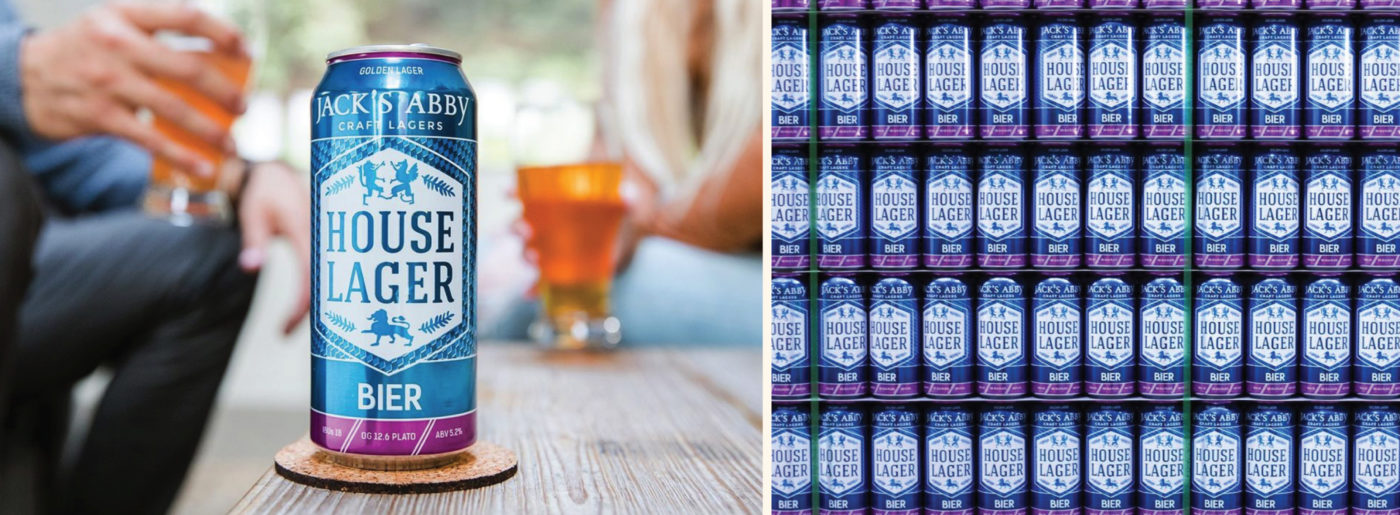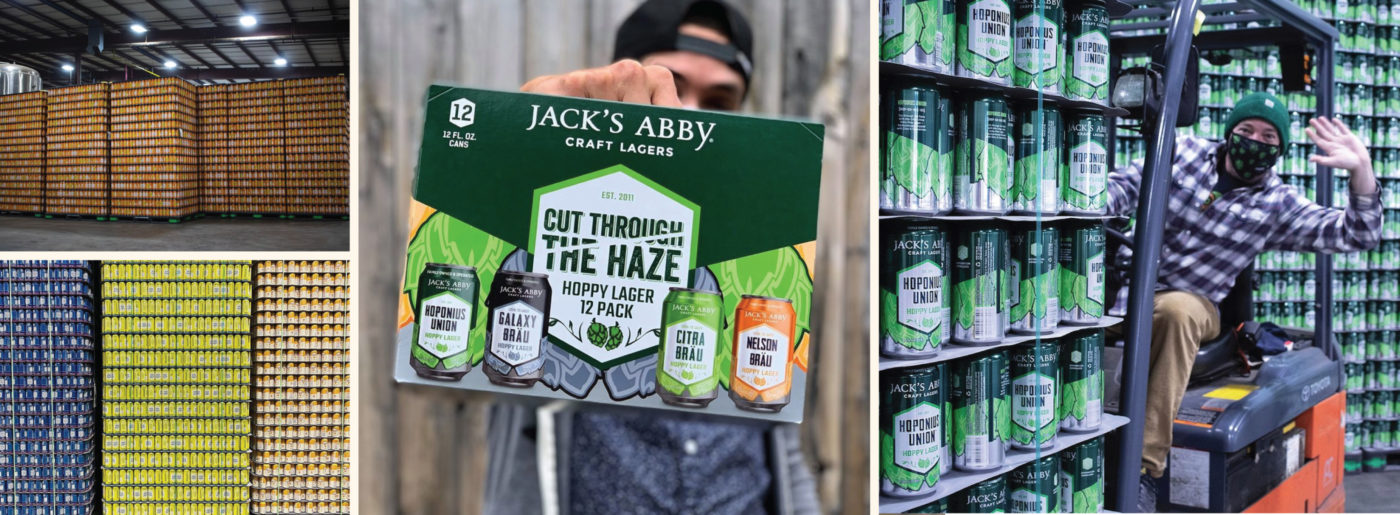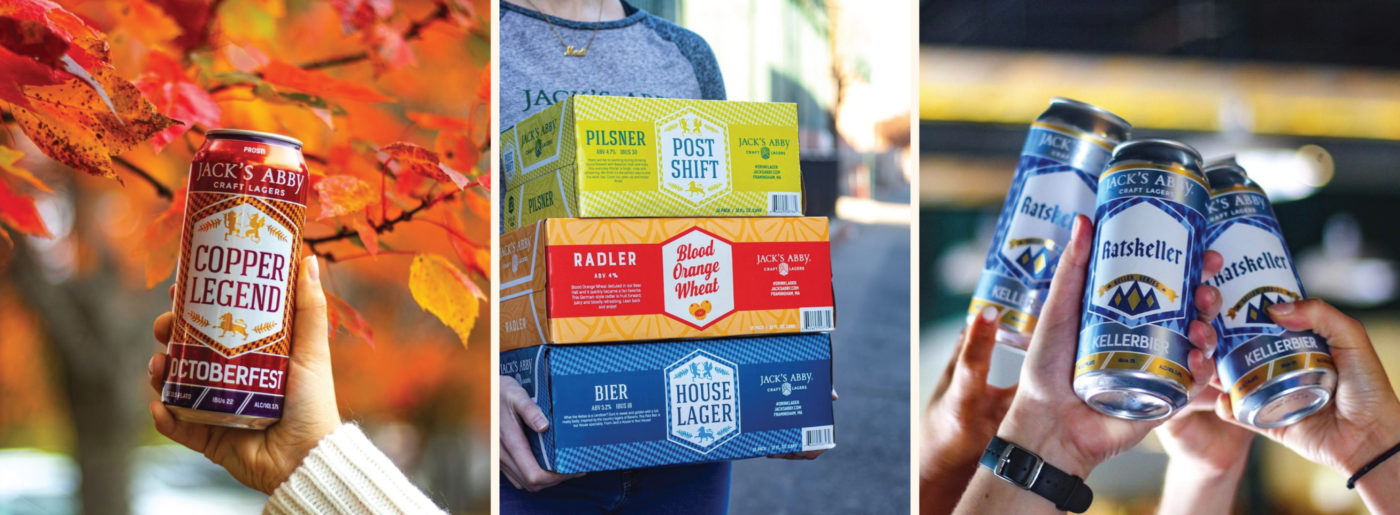Resources
In-House with Jack’s Abby
Positioning, Lagers and how brand values help to navigate troubled waters
It’s harder than ever to cut through the noise and stand out in today’s fractured beer market. This is true for startup breweries and established concerns alike—there’s just so much beer being made that you have to have a clear and compelling reason for people to consider your brand.
You have to have phenomenal beer and world-class branding, like always. But then you also have to have a well-oiled sales and marketing machine. And your distribution needs to be squared away. And on and on and on. One way to—I won’t say short cut, but rather, make it easier for people to grasp what your brewery stands for and why they should care—is to focus on your positioning.
Positioning isn’t just a task you check off of your business planning list, but rather an important way of determining how you are *actually* different from your competition. Not necessarily better, but different enough for people to quickly understand when and why they should buy your beer.
And beyond powerful origin stories, and fun brand names and identities and even cause-based brands, one of the cleanest ways of achieving concrete positioning is to hone in on a single beer style and execute it well all day, every day. For today’s In-House conversation, I reached out to a brewery who is doing just that.
Jack’s Abby Craft Lagers is a renowned lager brewery. Their beer is phenomenal, their branding is great, and they navigated the pandemic expertly. It would be easy to have (no value judgement here) released a hard seltzer, or hazy IPA last year when everyone was on their heels trying to figure out what the next move was while navigating lockdowns. But rather than be reactive, Jack’s Abby’s Senior Director of Marketing, Rob Day, and his team doubled down on what makes their brewery noteworthy in the first place. And they’re reaping the benefits of those moves every day.
Let’s discuss some of their behind the scenes thinking and see what could apply to your brewery’s branding and positioning.


Hi Rob. Please introduce yourself and tell the readers what you do at Jack’s Abby Craft Lagers.
 Rob
Rob
Hello Readers! I am Rob Day and I help shape and share the story of Jack’s Abby Brewing Co. Officially, I am the Senior Director of Marketing.

Can you give us a run down on Jack’s Abby—how was the brewery started, what kind of beers do you brew, annual bbls brewed and distribution footprint?
 Rob
Rob
This feels like it could be best answered with a “How it started. How it’s going.” Meme, but I’ll try to do better. Jack’s was founded by the 3 Hendler brothers—Jack, Eric and Sam. They grew up in an entrepreneurial family, but with the family business sold, they had to carve their own frontier.
Jack (the eldest) fell in love with brewing, especially the historic, traditional, and exceptional brewing techniques in Germany. After training in these methods he saw an obvious lack of quality, interesting, craft brewed lagers in the US. This was 10 years ago mind you and lagers were still the domain of big beer. So he gathered up his brothers and dove head first into this crazy adventure.
Today, we operate in a northeast regional distribution footprint covering all of New England, New York, and New Jersey. We currently sell just under 50,000 bbls of beer per year in that territory.
Our portfolio is extremely diverse for a lager brewery. Of course, we toil over the perfect pilsner and legendary fest beer. But we also helped invent the IPL category, and have been known to make an Imperial Baltic Porter or Lager Wine. If it can be lagered—we’ll probably try it.

I’m already a true believer, but for the unwashed who haven’t seen the light—why lagers? Why should people be excited about this “old” beer style?
 Rob
Rob
Lagers are amazing and in the brewing community often more revered than ales. They are incredibly challenging to make because when done properly the yeast bears little-to-no expression. It finishes completely clean to allow your other ingredients to shine, which also gives them nothing to hide behind. You need superb malts, carefully applied hops and a wealth of experience in managing time, temperature and taste to master the category.
As to some of the history, they are a relatively newer phenomenon than ales. Lagers didn’t really become super popular until the 1860’s. However, they did go on a world tour around then through trade and immigration which flowed right here to the USA. I think they may “feel old” because our perception is skewed by post prohibition dominance of big beer making oceans of fizzy same-ness. It’s the beer your great grandfather drank—right?
If you put the technique and history aside, lagers still offer an incredibly refreshing beer that can be manipulated by skilled brewers to craft a wide world of amazing flavors. That’s why you can get excited.

Build a stronger brand.
Sell more beer.
Join 7,500+ other beer industry folks and sign up for our monthly Beer Branding Trends Newsletter.

Beer Branding Trends 2.0

Craft consumers want variety and novelty (to some degree), which favors the generalist brewery. But Jack’s Abby specializes in lagers. Do you ever get feedback from customers who want a more current style, like a hazy IPA, for instance, or are you able to meet your customers where they are by brewing only one style?
 Rob
Rob
I think we are able to satisfy a wide range of beer fans by sticking to lagers. As I was saying in the previous question, you can create an excited array of beers in the lager only world.
More importantly though [soap box warning]. I think it’s absolutely critical for a craft brewery to have a reason to be. Why do you exist? What makes you special?
Most anyone can recite some version of the line “If you try to be everything to everyone then you end up being nothing to no one.” But who really lives that? Which breweries can clearly identify their WHY and build a company around it? You need to do that in this world. The competition is too fierce. The consumers are too discerning. You need a reason to exist, and you need to find people who care.
We make some of the best lagers in the country and we live a set of values we can be proud of. Now it’s our job to find the people who align with that and share our story.
But hey, if you want a Hazy IPA then I hope you hit up one of the brands making some great ones!

What drew you to going in-house vs. finding an agency gig?
 Rob
Rob
Coming out of college I was certain that I would go the agency route. I studied the great ad agencies religiously, and even toured several throughout college. My first job was selling advertising to CPG companies and the first recession knocked that out, pushing me in-house by default.
Looking back, this is exactly how it needed to be. Agency has its benefits, but I really enjoy being fully-integrated into the company I am working for. You get to develop a sixth sense for the personality of the brand that is very hard to do from the outside. I learn nuanced things that can be expressed in big ways.
Sometimes I feel more akin to an anthropologist. I’m fully embedded with this culture that some time not long ago was completely foreign. I’ve got to learn the language, the internal workings, and the true motivations and then express those to the outside world. It’s exciting and always interesting.

We’re coming off of one hell of a year for breweries. How did your role as a marketing director shift as the country wrestled with COVID?
 Rob
Rob
What’s my word count here? Half kidding. My hot take is that fundamentally—nothing changed. My job at the highest level is the shape and share the story of Jack’s Abby. That’s exactly what I am doing today. The story is always changing. Our consumers are changing. In this role, you have to constantly be evolving.
I’m sure buried in this question is some curiosity on how the details changed though, and that’s been like saddling up the cow swirling in the tornado. To best understand this, it’s important to know the business cycle of craft brewing and where we were in March.
We start planning the next year in July and present this to our distribution network in October–December. It’s an extremely long and detailed process to align all of our goals internally and then externally.
Part of that plan for 2020 was the relaunching of our Springdale brand of beers. This was slated for the third week of January and was the prime focus for Jan and February. Essentially speaking, by March we should have just been walking out the execution for all of the work we set up. Unfortunately, all of that went out of the window immediately and we had to start over mid stride.
I liken this part to training for a race while running it. Rally the team. Generate ideas. Roll out something. Evaluate it—FAST. Is it working? Do more. Didn’t land? Drop it. Spend the first 3 weeks accepting that this sucks. Stop worrying about that week 4 and start asking what can we do? Rally the team again. Try some digital versions of real life activities. Change your beer list again. Evaluate it—FAST! Government changes a few rules; adapt again.
That’s the idea. My role is the same. The speed changed, and I am blessed to have a team ready, willing, and able to run with me.

Give us a rundown of your creative department. How many designers, social media folks, creatives, etc. round out your team?
 Rob
Rob
I currently run a team consisting of 5 of the most talented beer marketers in the game.
Kat: PR and Events Manager
Kelly: Assistant Marketing Manager
Anna: Graphic Designer II
Katie: Graphic Designer I
Jordan: Social Media Manager

What is the biggest challenge you face as a marketing director?
 Rob
Rob
Always a good question, and I never have a great answer. I think the biggest challenge I am currently facing is navigating a very opaque and narrow path of professionalizing the business and marketing efforts while also trying to maintain the charm and personality that makes us who we are.
The increased competition, rapid changing environment and increasing expectations have created the need to professionalize. We have to be organized, concise and compelling to get a message from “brain to bodega.” That takes a different kind of effort than what this industry was built on.
That being said, we can’t become suits and ties. Our personality is our competitive advantage and that needs to shine through or we’re in trouble.

Are you involved in developing new beer releases / names from a branding standpoint or is that driven entirely by the brewing staff?
 Rob
Rob
Absolutely! This is an EXTREMELY collaborative effort and it needs to be. Some names / beers go straight from my brain to the shelf. Some from my team. Some from brewing staff and some from our founders as well. It’s both the most fun and thankless job in the business. We need a lot of minds on it pulling from different perspectives.

Jack’s Abby’s sister company, Springdale Beer Co., recently refreshed its branding and packaging. Can you tell us what lead to that decision?
 Rob
Rob
I have to introduce a pretty big distinction here that I was hinting at in a previous question. Jack’s Abby Brewing Co. operates two brands: Jack’s Abby Craft Lagers and Springdale Beer Co.
To this point we’ve almost solely addressed Jack’s Abby Craft Lagers, but this question is about Springdale Beer Co. This is a completely separate brand with its own taproom, communications, and of course beer portfolio.
Springdale is the brand that we refreshed this year and the decision was very organic and obvious for us. In 2016 the Jack’s Abby team was feeling the itch to experiment with IPA / barrel aged sours and broader expressions of fermentation. But as we’ve discussed, that did not fit the Jack’s Abby brand. So the brothers decided to establish another brand that could operate on its own.
The team secured another space right on our block and Springdale was born. However, it was born with a little bit of an identity crisis. There was naturally a lot of good DNA in the brand, but not much clarity on why this brand existed, what it meant, and who it was for.
By the beginning of 2019 this was obvious to the team and they started the conversations around a brand refresh. I was brought on later in the year to run this process and re-launch Springdale in 2020.
Having been around for a while, this decision is not so obvious. You all at CODO do a phenomenal job on content related to rebranding and refreshing that addresses the wider range of how people get here. To boil it down, when you see a significant disconnect in what you believe you are and what people think of you, then it’s time to reconsider the brand.

Did you run into any challenges during the refresh (e.g. internal consensus gathering or concerns about not losing brand equity)?
 Rob
Rob
This answer does not make for a great story, but not really. I was blessed with a brand that had good DNA and a team that wanted change and was open to the process. We started very carefully with interviews and conversations on what this brand meant and why it existed and marched that through the process of definition and creation. This progression made the process very smooth.
Of course there were minor debates on beer names, or edits to the logo, but all in all it was very smooth. You can’t skip those initial steps to get it right and ensure there is buy-in. I think that’s where most people veer off course.

We believe good design is good business. What have you seen, or directly influenced at Jack’s Abby, that backs up this claim?
 Rob
Rob
We’ve had several, but I’ll speak to two categories on the Springdale Beer Co. side that are just living this mantra. Part of the re-launch was to make a ‘seasonal’ program for 4 tart ales and organize our hazy beer releases around music theme. For these to even exist, the design had to be WOW!
For the tart ales, we spent a lot of time learning what people liked about them and it boiled down to the simplicity of flavor combinations. So we stripped the more beer geeky terms off, brightened the color pallete and let the fruit and floral flavors be the hero. This lineup has become incredibly successful in its first year and will be continuing with more emphasis next year.
The hazy beers of past were a little disjointed. So we organized these around a Springdale 2020 playlist on Spotify and prepared to drop a new track every month. The design need here was the opposite of tart ales. This line needed an artistic wow factor that snagged the eye and had layers of story to peel back for those who wanted to engage. That’s how people appreciate music and we needed to reflect that. That series was also incredibly successful this year and is returning bigger and better next year.

What other breweries (or non-beer brands) branding and packaging do you admire?
 ROB
ROB
Oh so many! Since you were so kind to have me on here, I’d like to share some compliments for your work first. Two projects CODO has done that really speak to me are Left Field Brewery and Printer’s Ale Manufacturing Co. I think these exhibit a clear self confidence in brand and speak loud and proud to the right audience. A recent beer that crossed my path and stopped be is Brighter Days Brewing. It’s extremely visceral for a relatively simple idea and I love when you can illicit so much from as little as possible. A non-beer brand that has impressed me recently is TRUFF hot sauce. Every element is so carefully crafted, and it legit pushes you to hit the buy now button right from Instagram. There’s so many more, but I think we could have a whole conversation on that categorically.

Any book / podcast recommendations that you think all marketing directors should check out?
 ROB
ROB
I only recently started with podcasts and none are marketing based yet so I’ll tap into the old paper library for this one.
• Brandwashed. Absolutely 100% must read.
• Trust Me, I’m Lying. A must read to fully understand PR and media today. A legit curtain pull.
• Tipping Point. A good baseline of behavioral economics.
• How Disruption Brought Order. Jean Marie-Dru was CEO of TBWA one of the most epic ad agencies of all time and pioneered the concept of disruption. Still relevant stuff today and multiple follow up books.
• The entire Seth Godin catalog. Seriously, many of them are bite sized. Pick one and jump in.

Beyond those recommendations, how do you stay sharp and up-to-date on emergent trends?
 ROB
ROB
You have to start from a place of genuine curiosity and desire to learn. This field changes by the hour and if you aren’t hungry to learn more then it’s exhausting. I have about 12 newsletters fed to me throughout the week that I skim or dig in detail. I’ve audited online courses from universities. I take book recommendations from others and read them. I take chances on webinars—scary I know. I also start with an open mind and take meetings that I otherwise probably shouldn’t and really try to learn and open my perspective. Always ask questions. Always have conversations. Never stop.

What project are you most proud of, to date?
 ROB
ROB
I am extremely proud of our musically inspired Hazy IPA series and how we brought it to life this year. I discussed the project a bit in the summary of rebranding, but looking back, it’s pretty remarkable that this series came to life, continued through COVID and we were able to find unique and genuine ways to promote it. We met new artists through our sessions and conversations. We shared good times remotely with a broader audience. We tapped into a real powerhouse of inspiration that music is for all of us here. It’s just one of those perfect projects that survives despite the odds and has so much heart in it.

Thanks so much for your time, Rob. I’m looking forward to grabbing beer with you at CBC this year.
 ROB
ROB
Just this phrase gets me wicked excited. Grabbing a beer with people in a place… LETS GO!!!

Build a stronger brand.
Sell more beer.
Join 7,500+ other beer industry folks and sign up for our monthly Beer Branding Trends Newsletter.



